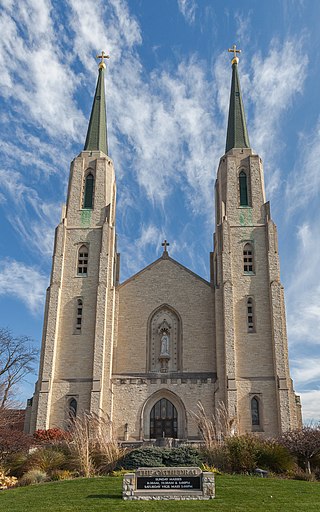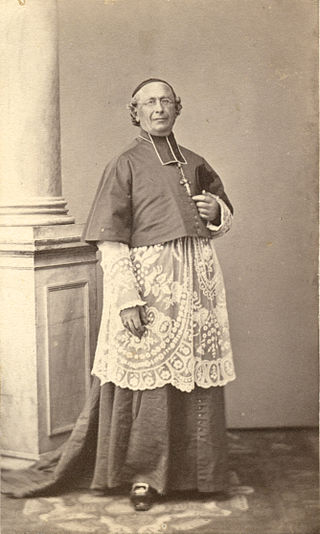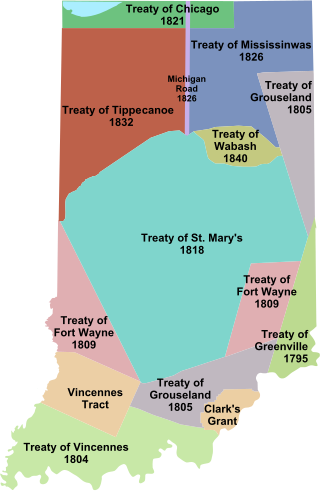
The Potawatomi, also spelled Pottawatomi and Pottawatomie, are a Native American people of the Great Plains, upper Mississippi River, and western Great Lakes region. They traditionally speak the Potawatomi language, a member of the Algonquin family. The Potawatomi call themselves Neshnabé, a cognate of the word Anishinaabe. The Potawatomi are part of a long-term alliance, called the Council of Three Fires, with the Ojibway and Odawa (Ottawa). In the Council of Three Fires, the Potawatomi are considered the "youngest brother" and are referred to in this context as Bodéwadmi, a name that means "keepers of the fire" and refers to the council fire of three peoples.

Mount St. Mary's University is a private Roman Catholic university in Emmitsburg, Maryland. It has the largest Catholic seminary in the United States. Undergraduate programs are divided between the College of Liberal Arts, the Richard J. Bolte School of Business, and the School of Natural Science and Mathematics. "The Mount" has over 40 undergraduate majors, minors, concentrations, and special programs, as well as bachelor's/master's combinations in partnership with other universities, 8 master's programs, and 6 postgraduate certificate programs.

Edward Frederick Sorin, C.S.C. was a French-born priest of the Congregation of Holy Cross and the founder of the University of Notre Dame in Indiana and of St. Edward's University in Austin, Texas.

Anne Thérèse Guérin, designated by the Vatican as Saint Theodora, was a French-American saint and the foundress of the Sisters of Providence of Saint Mary-of-the-Woods, a congregation of Catholic sisters at Saint Mary-of-the-Woods, Indiana. Pope John Paul II beatified Guérin on 25 October 1998, and Pope Benedict XVI canonized her a saint of the Catholic Church on 15 October 2006. Mother Guérin's feast day is 3 October, although some calendars list it in the Roman Martyrology as 14 May, her day of death.

The Diocese of Fort Wayne–South Bend is a Latin Church ecclesiastical territory, or diocese, of the Catholic Church in north-central and northeastern Indiana in the United States.

The Archdiocese of Indianapolis is a Latin Church diocese of the Catholic Church in Indiana in the United States.

Stephen Theodore Badin was the first Catholic priest ordained in the United States. He spent most of his long career ministering to widely dispersed Catholics in Canada and in what became the states of Kentucky, Ohio, Indiana, Michigan, and Illinois.

Leopold Pokagon was a Potawatomi Wkema (leader). Taking over from Topinbee, who became the head of the Potawatomi of the Saint Joseph River Valley in Michigan, a band that later took his name.

Simon William Gabriel Bruté de Rémur was a French missionary in the United States and the first bishop of the Diocese of Vincennes, Indiana. President John Quincy Adams called Bruté "the most learned man of his day in America."

The Potawatomi Trail of Death was the forced removal by militia in 1838 of about 859 members of the Potawatomi nation from Indiana to reservation lands in what is now eastern Kansas.
Anthony Deydier, was a French priest, missionary and teacher.

George Winter was an English-born landscape and portrait artist who immigrated to the United States in 1830 and became an American citizen in northern Indiana's Wabash River valley. Winter was one of Indiana's first professional artists. In addition, he is considered the state's most significant painter of the first half of the nineteenth century. Winter is especially noted for his sketches, watercolors, and oil portraits that provide a visual record of the Potawatomi and Miami people in northern Indiana from 1837 to the 1840s, as well as other figures drawn from his firsthand observations on the American frontier.

Célestin René Laurent Guynemer de la Hailandière was a French prelate of the Roman Catholic Church. He served as Bishop of Vincennes from 1839 to 1847. He is perhaps best known for donating the land for the establishment of the University of Notre Dame.
Jacques-Maurice des Landes d’Aussac de Saint Palais was an American prelate of the Roman Catholic Church. He served as the fourth Bishop of Vincennes, from 1848 until his death.

Indian removals in Indiana followed a series of the land cession treaties made between 1795 and 1846 that led to the removal of most of the native tribes from Indiana. Some of the removals occurred prior to 1830, but most took place between 1830 and 1846. The Lenape (Delaware), Piankashaw, Kickapoo, Wea, and Shawnee were removed in the 1820s and 1830s, but the Potawatomi and Miami removals in the 1830s and 1840s were more gradual and incomplete, and not all of Indiana's Native Americans voluntarily left the state. The most well-known resistance effort in Indiana was the forced removal of Chief Menominee and his Yellow River band of Potawatomi in what became known as the Potawatomi Trail of Death in 1838, in which 859 Potawatomi were removed to Kansas and at least forty died on the journey west. The Miami were the last to be removed from Indiana, but tribal leaders delayed the process until 1846. Many of the Miami were permitted to remain on land allotments guaranteed to them under the Treaty of St. Mary's (1818) and subsequent treaties.
The Diocese of Vincennes was the first Latin Church diocese in Indiana. It was erected 6 May 1834 by Pope Gregory XVI. Its initial ecclesiastical jurisdiction encompassed Indiana as well as the eastern third of Illinois. In 1843 the Diocese of Chicago was erected from the Illinois portion of the diocese, and in 1857 Diocese of Fort Wayne was erected from the northern half of Indiana. The seat of the episcopal see was transferred from Vincennes, Indiana, to Indianapolis, and on 28 March 1898 it became the Diocese of Indianapolis. Pope Pius XII elevated the Indianapolis diocese to an archdiocese in 1944, and erected two new Indiana dioceses: the Diocese of Evansville and the Diocese of Lafayette. The Diocese of Gary, Indiana, was erected in 1956. The Evansville Diocese absorbed the city of Vincennes upon its creation.

Menominee was a Potawatomi chief and religious leader whose village on reservation lands at Twin Lakes, 5 miles (8.0 km) southwest of Plymouth in present-day Marshall County, Indiana, became the gathering place for the Potawatomi who refused to remove from their Indiana reservation lands in 1838. Their primary settlements were at present day Myers Lake and Cook Lake. Although Menominee's name and mark appear on several land cession treaties, including the Treaty of St. Mary's (1818), the Treaty of Mississinewas (1826), the Treaty of Tippecanoe (1832), and a treaty signed on December 16, 1834, he and other Potawatomi refused to take part in subsequent land cession negotiations, including the Treaty of Yellow River (1836), that directly led to the forced removal of Menominee's band from Indiana in 1838.

The St. Francis Xavier Cathedral is a parish of the Roman Catholic Church in Vincennes, Indiana, under the Diocese of Evansville. Named for Francis Xavier, a 16th-century Jesuit apostle, it is located opposite George Rogers Clark National Historical Park at 205 Church Street, within the Vincennes Historic District.

The University of Notre Dame was founded on November 26, 1842, by Father Edward Sorin, CSC, who was also its first president, as an all-male institution on land donated by the Bishop of Vincennes. Today, many Holy Cross priests continue to work for the university, including as its president. Notre Dame rose to national prominence in the early 1900s for its Fighting Irish football team, especially under the guidance of the legendary coach Knute Rockne. Major improvements to the university occurred during the administration of Rev. Theodore Hesburgh between 1952 and 1987 as Hesburgh's administration greatly increased the university's resources, academic programs, and reputation and first enrolled women undergraduates in 1972.
Christiaan Jacob Adriaan Hoeken, SJ (1808–1851) was a Jesuit missionary of Dutch origin who worked in the United States among the first nations. He wrote several books in Potawatomi and founded St. Ignatius Mission among the Kalispel. Hoecken died of malaria sailing up the Missouri River.















